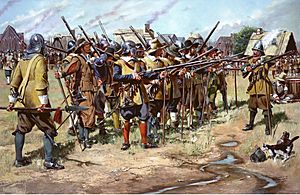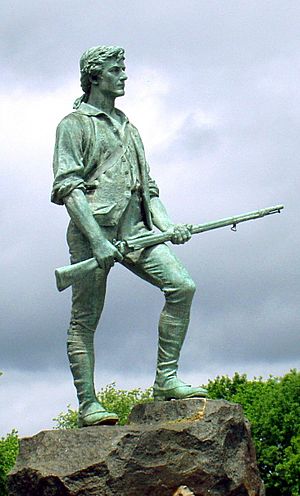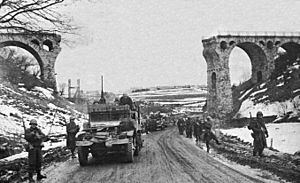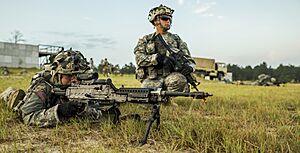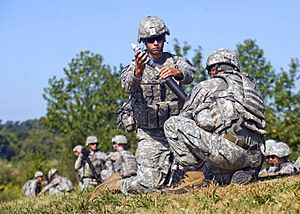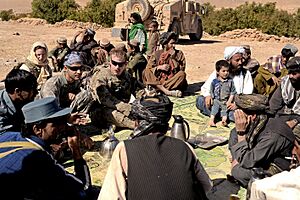Massachusetts National Guard facts for kids
Quick facts for kids Massachusetts National Guard |
|
|---|---|
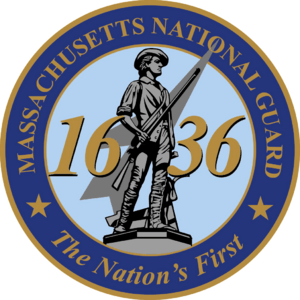
Seal of the Massachusetts National Guard
|
|
| Active | 1636–present (389 years) |
| Countries | (1636–1686, 1689-1692) (1686-1689) (1692-1775) (1775-1776) (1776–present) |
| Allegiance | |
| Branch | |
| Role | Federal Reserve Force State Militia (Militia Act of 1903) |
| Motto(s) | (Latin) Ense petit placidam (English: By the sword we seek peace) |
| Engagements | Colonial Wars
Pequot War Revolutionary Period
American Wars
Korean War |
| Decorations | Superior Unit Award (IFOR Service) |
| Commanders | |
| Commander in Chief (Title 10 USC) | President of the United States (Federalized) |
| Commander in Chief (Title 32 USC) | Governor of Massachusetts |
| Adjutant General | Major General Gary W. Keefe |
| State Command Sergeant Major | Command Sergeant Major James L. Campbell Jr. |
| Notable commanders |
John Winthrop Myles Standish (Plymouth Company Commander) |
| Insignia | |
| Shoulder Sleeve Insignia | 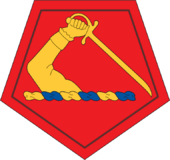 |
The Massachusetts National Guard is a part of the United States National Guard. It serves the state of Massachusetts. Founded on December 13, 1636, it has some of the oldest military units in the United States Army.
The Massachusetts National Guard started as a defense group for early settlers. Over time, it became a strong and organized fighting force. It played a key role in the American Revolutionary War. Today, it is based at Hanscom Air Force Base. Major General Gary W. Keefe leads it.
Soldiers and airmen in the Massachusetts National Guard train like the regular United States Army and United States Air Force. They use the same ranks and symbols. They can earn all US military awards, plus special state awards. They also meet the same fitness and training standards as active-duty troops.
Contents
History of the Massachusetts National Guard
How the Guard Started in Massachusetts
Soon after the Massachusetts Bay Colony was founded, leaders began to organize a militia. All men aged 16 to 60 had to serve. These militiamen were well-trained and armed. Unlike militias in England, all New England militiamen trained the same way.
They could also choose their own officers. This was a big difference from other militias. A group of men, called a company, had at least 64 soldiers. They trained six days a year.
Before 1636, each town had its own militia company. On December 13, 1636, the Massachusetts militia became more organized. It was split into North, South, and East Regiments. Today's 181st Infantry Regiment, 101st Field Artillery Regiment, and 101st Engineer Battalion (United States) come from these original groups.
Three years later, the Hampshire Regiment was formed in Springfield, Massachusetts. The 104th Infantry Regiment traces its history to this unit.
King Philip's War
During King Philip's War (1675-1678), many towns were attacked. About 3,000 colonists died. A force of about 1,000 militiamen fought back. This war was very bloody for everyone in New England. More than 10% of the people died.
Growing the Militia
As time went on, bigger towns had more than one militia company. Companies from nearby towns formed regiments, led by colonels. Regiments then formed brigades, led by brigadier generals.
In 1692, Plymouth Colony joined the Massachusetts Bay Colony. Its militia became part of the Massachusetts Militia. Captain Myles Standish first led the Plymouth Colony militia in 1621.
The American Revolution
Before the American Revolution, Massachusetts had two main groups of armed citizens. The "regular" militia included all white men aged 16 to 60. The Minutemen were better trained and could respond very quickly.
On April 19, 1775, the Lexington militia faced British forces. This led to the "shot heard round the world." It marked the start of the American Revolution. Militiamen fought the British as they went back to Boston.
After the battles of Lexington and Concord, Massachusetts militia units joined forces. They formed the Army of Observation. Their goal was to keep the British from leaving Boston. This army fought at the Battle of Bunker Hill in June 1775.
General George Washington took command in July 1775. The militia units then became part of the new Continental Army. Massachusetts regiments were a big part of this army throughout the war.
War of 1812
In 1814, British forces took over parts of Maine. People worried they would attack other New England cities. Massachusetts militia units were called to protect Boston and other coastal areas.
Some units today, like the 181st Infantry Regiment (United States), 182nd Infantry Regiment (United States), 101st Field Artillery Regiment, and 772nd Military Police Company, earned honors for their service in this war.
Militia Law of 1840
The Massachusetts Militia Law of 1840 made big changes. It created two types of militia:
- The enrolled militia was a list of men aged 18 to 45. They would only be called in wartime. They did not train regularly.
- The volunteer militia (MVM) were people who joined and trained often. The MVM was organized into divisions, brigades, and regiments.
American Civil War
When the American Civil War began in 1861, Massachusetts Militia units joined the Union Army. From 1864 to 1865, 27 special companies were called to guard coastal forts in Massachusetts. Most of these came from existing volunteer militia units.
Spanish-American War
During the Spanish–American War, six Massachusetts Volunteer Militia regiments served. These included infantry and artillery units. The 2nd, 8th, and 9th regiments fought in Cuba. The 6th regiment saw action in Puerto Rico. All units were sent home by May 1899.
The National Guard is Formed
The Militia Act of 1903 created the National Guard as we know it today. States could get money from the federal government. In return, their militia units would agree to serve in federal emergencies.
This law helped state militias become better trained and equipped. The National Defense Act of 1916 made them train even more. This meant that when National Guard units were called to fight in World War I, they were much more ready.
World War I
During World War I, the 26th Division, also called the "Yankee Division," was formed. It was made up of Massachusetts National Guard units. The division fought for 210 days. It took part in major battles like St. Mihele and Meuse-Argonne.
World War II
Like in World War I, Massachusetts National Guard units were called to federal service. Most were in the 26th Infantry Division or the 241st Coast Artillery. The 181st Infantry Regiment guarded the coasts of Massachusetts and other New England areas.
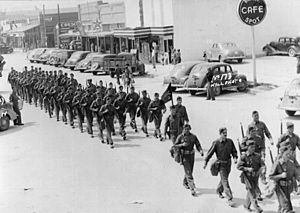
After World War II
The Massachusetts Army National Guard reorganized in 1946. The 26th Infantry Division was the largest group. When the Korean War started in 1950, eight non-divisional units were called to active duty.
During the Vietnam era (1965-1972), many men joined the National Guard to avoid being drafted. This helped fill the Guard's ranks. In the early 1980s, the National Guard got more federal money. It became a very well-trained and professional force. Units were ready for the Gulf War in 1990-1991.
After the Cold War, the Army made some changes. The 26th Infantry Division became a smaller brigade. It was then placed under the command of the 29th Infantry Division.
The Post-9/11 Era
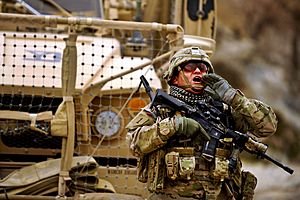
Many Massachusetts National Guard units have served overseas. They were called to duty in Operation Enduring Freedom in Afghanistan (2001-2021). They also served in Operation Iraqi Freedom in Iraq (2003-2011).
In 2005, the 26th Infantry Brigade became the 26th Infantry Brigade Combat Team. Later, it was reorganized as the 26th Maneuver Enhancement Brigade (MEB). This is a combat support brigade.
On October 29, 2007, Major Jeffrey R. Calero was killed in Kajaki, Afghanistan. He died from a roadside bomb during a patrol.
How the Guard is Organized and What it Does
The Massachusetts National Guard has two parts: the Massachusetts Army National Guard and the Massachusetts Air National Guard. Officers hold two commissions. One is from the Governor of Massachusetts. The other is from the President of the United States. This shows the Guard's role as both a state and national military force.
As a state organization, the Governor can call on the Guard. They help with natural disasters and public safety emergencies. In its national role, the Guard can be called for active service with the United States Armed Forces. Massachusetts National Guard units have served in many wars. These include World War I, World War II, the Korean War, the Gulf War, the War in Iraq, and Operation Enduring Freedom in Afghanistan.
The Governor technically leads the National Guard. The state adjutant general helps the Governor. This general holds the rank of major general. National Guard members train one weekend a month. They also do Annual Training for 15–30 days each year.
Units of the Massachusetts Army National Guard
Camp Edwards on Cape Cod, Massachusetts is a main training site. Current units include:
- Headquarters and Headquarters Company
 26th Maneuver Enhancement Brigade
26th Maneuver Enhancement Brigade 101st Field Artillery Regiment
101st Field Artillery Regiment 101st Engineer Battalion
101st Engineer Battalion 151st Regional Support Group
151st Regional Support Group
- 164th Transportation Battalion
- 3rd Battalion, 126th Aviation Regiment
- D Company, 223rd Military Intelligence Battalion
 1st Battalion, 181st Infantry Regiment (part of 44th Infantry Brigade Combat Team, NJ Army National Guard)
1st Battalion, 181st Infantry Regiment (part of 44th Infantry Brigade Combat Team, NJ Army National Guard) 1st Battalion, 182nd Infantry Regiment (Part of 27th Infantry Brigade Combat Team, New York ARNG)
1st Battalion, 182nd Infantry Regiment (Part of 27th Infantry Brigade Combat Team, New York ARNG) Company C, 1st Battalion, 20th Special Forces Group
Company C, 1st Battalion, 20th Special Forces Group 211th Military Police Battalion ("First Corps of Cadets")
211th Military Police Battalion ("First Corps of Cadets")- 101st Regiment (Regional Training Institute)
- 54th Massachusetts Volunteer Regiment
Massachusetts Air National Guard
Otis Air National Guard Base and Barnes Air National Guard Base are the main bases for the Massachusetts Air National Guard.
Massachusetts National Guard Museum and Archives
The Massachusetts National Guard Museum and Archives is in Concord, Massachusetts. It is located in an armory there.


